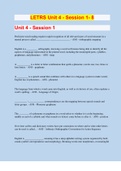LETRS Unit 4 - Session 1 - 8 Unit 4 - Session 1 Proficient word reading requires rapid recognition of all relevant layers of word structure in a mental process called ___________ ________________. - ANS - orthographic mapping English is a _________ orthography, knowing a word well means being able to i dentify all the aspects of language represented in the printed word, including the meaningful parts, syllables, graphemes, and phonemes. - ANS - deep A ___________ is a letter or letter combination that spells a phoneme; can be one, two, three or four let ters. - ANS - grapheme A _________ is a speech sound that combines with others in a language system to make words; English has 44 phonemes. - ANS - phoneme The language from which a word came into English, as well as its history of use, often explains a word's spelling. - ANS - Language of Origin __________ -_____________ correspondences are the mapping between speech sounds and letter groups. - ANS - Phoneme -grapheme The ________ of a phoneme or grapheme in a word refers to whether it is at the beginni ng, middle or end of a syllable and what sounds (or letters) come before or after it. - ANS - position Over time scribes and dictionary writers have put constraints on where and in what order letters can be used is called... - ANS - Arbitrary Orthographic Conventions for Letter Sequence English is _______________, meaning it has a deep alphabet writing system organized by both sound -symbol correspondence and morphology. Breaking words into morphemes, or meaningful parts, often provides clues as to how to spell the word and what it means. - ANS - morphophonemic Short one syllable words, compounds, vowel teams, silent letters, digraphs, dipthongs in spelling, words for common everyday things and irregular spellings of high -frequency words. - ANS - Anglo -Saxon (Old English) ou for /u/, soft c and g when followed by e, i, y, special endings such as -ine, -ette, -elle, -ique, words for food and fashion, abstract social ideals, relationships - ANS - Norman French Multisyllabic words with prefixes, roots, suffi xes, content word found in texts on social sciences, traditional physical sciences, literature - ANS - Latin/Romance ph for /f/, ch for /k/, and y /i/, combining forms, similar to English Compounds, philosophical, mathemtical, and scientific terminology - ANS - Greek ch in Anglo -Saxon (English) /ch/ - ANS - church, speech, cheap, chain ch in French /sh/ - ANS - charade, machine, chef, chic ch in Greek /k/ - ANS - Christmas, chemist, stomach ou in Anglo -Saxon (English) /ou/ or /u/ - ANS - house, out, cloud, our round; touch rough, tough, enough ou in French /u/ - ANS - soup, coupon, group, acoustic ph in Greek /f/ - ANS - phone, graph, sphynx kn in Anglo -Saxon (English) - ANS - knock, knee, know, knight




